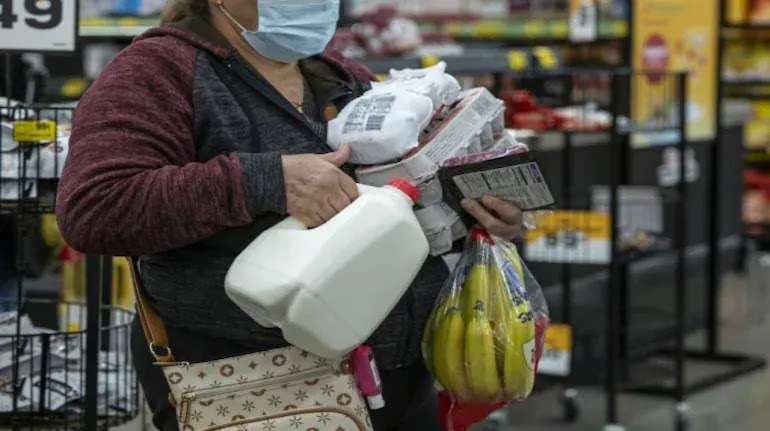Inflation Cools as CPI Data Shows Decline in Grocery Prices: Live Updates

Inflation in the United States has continued to show signs of cooling as the latest Consumer Price Index (CPI) data reveals a decline in grocery prices and a moderation in food costs. This provides some relief for Americans who have been grappling with a two-year inflationary surge. However, it's important to note that other expenses, particularly rent, are still on the rise.
The CPI, which is released by the Labor Department, indicates that consumer prices increased by 4% from the previous year in May. This figure represents a decline from the 4.9% increase observed in April and the 40-year high of 9.1% recorded in June last year. The 4% increase is the smallest yearly rise since March 2021. On a monthly basis, prices rose by 0.1% in May, following a 0.4% increase in April.
It is crucial to understand the difference between core CPI and CPI. Core prices, which exclude the volatile food and energy sectors and provide a better reflection of long-term trends, have been more challenging to control. They rose by 0.4% for the third consecutive month. Nevertheless, this resulted in a decrease in the annual core inflation rate from 5.5% to 5.3%, the lowest level seen since November 2021.
The Federal Reserve, which has been implementing aggressive interest rate hikes to curb inflation, now faces a quandary. The central bank is expected to pause its 14-month campaign of rate increases in light of the easing price pressures. However, the Fed remains concerned about persistently high core inflation levels.
The recent collapse of three regional banks has also played a role in the Fed's decision-making process. As a result, the central bank is likely to keep interest rates steady this week in order to assess the impact of the financial stress triggered by these events. So far, the impact of the crisis on the economy has been limited, as noted by Goldman Sachs.
Given the circumstances, some Fed officials have indicated a preference for skipping a rate increase this week while considering another hike in July. The final decision will be announced after the Fed's policy meeting on Wednesday, June 14, where economic projections for inflation, employment, interest rates, and economic growth will also be presented.
Gasoline prices, a major contributor to overall inflation, have seen a decline of 5.6% in May and are nearly 20% lower compared to the previous year. Despite some fluctuations, pump prices have remained relatively low due to concerns about a global recession and its impact on oil demand and prices. The national average for regular unleaded gasoline stood at $3.59 per gallon on Monday, slightly up from $3.54 a month ago but significantly lower than the peak of $5 observed in June 2022.
CPI holds significant importance for the Federal Reserve as it plays a crucial role in determining interest rate decisions. The central bank's mandate is to achieve price stability and maximum employment. Although the Fed's inflation target is around 2% as measured by the Personal Consumption Expenditures (PCE) price index, CPI receives more attention due to its use in adjusting social security payments and as a reference rate for certain financial contracts, as stated by the Cleveland Fed.
While CPI is an essential measure, it is not the only gauge of inflation considered by the Federal Reserve. The central bank's preferred inflation indicator is the PCE price index from the Bureau of Economic Analysis. PCE provides a different basket of goods and services and incorporates a wider group of people surveyed. Unlike CPI, PCE considers all direct and indirect consumer consumption, including costs covered by employer-provided insurance, Medicare, and Medicaid.
Additionally, PCE accounts for substitutions, adjusting the basket of goods in response to changes in consumer behavior.
In April, PCE prices increased by 0.4% compared to the previous month, with a year-over-year increase of 4.4%. Although this figure is down significantly from the 7% peak seen in June last year, it remains above the Fed's 2% target. Core PCE, which excludes volatile food and energy prices, rose by 0.4% from March to April and increased by 4.7% over the previous 12 months. Core PCE has remained relatively stable since reaching 4.6% in December.
Before the release of the CPI report, futures tied to the S&P 500 index and the Nasdaq-100 indicated positive trends in the stock market, while Dow futures showed a slight decline.
In summary, the recent CPI data indicates a further slowdown in inflation, primarily driven by a decline in grocery prices and a moderation in food costs. While the Federal Reserve faces a dilemma in terms of interest rate decisions, the easing price pressures provide some relief for Americans. Gasoline prices have also seen a decline, contributing to the overall cooling of inflationary pressures. It is important to note that CPI is not the sole measure of inflation considered by the Federal Reserve, with the central bank also relying on the PCE price index to assess price trends and make policy decisions.





No comments